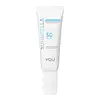What's inside
What's inside
 Key Ingredients
Key Ingredients

 Benefits
Benefits

 Concerns
Concerns

 Ingredients Side-by-side
Ingredients Side-by-side

Water
Skin ConditioningGlycerin
HumectantPropylene Glycol
HumectantPolymethyl Methacrylate
PPG-24-Glycereth-24
EmulsifyingButyl Methoxydibenzoylmethane
UV AbsorberEthylhexyl Triazone
UV AbsorberAcrylates/C10-30 Alkyl Acrylate Crosspolymer
Emulsion StabilisingAminomethyl Propanol
BufferingPhenoxyethanol
PreservativeHydroxyacetophenone
AntioxidantAllantoin
Skin ConditioningButylene Glycol
HumectantXanthan Gum
EmulsifyingDisodium EDTA
Pentylene Glycol
Skin ConditioningSodium Hyaluronate
HumectantGentiana Scabra Root Extract
Skin ConditioningPropanediol
SolventEctoin
Skin ConditioningArmillaria Mellea Extract
Skin ConditioningZea Mays Starch
AbsorbentHydrogenated Lecithin
EmulsifyingHydrolyzed Corn Starch
HumectantHydrolyzed Corn Starch Octenylsuccinate
AbsorbentLimonia Acidissima Extract
Skin ConditioningButyrospermum Parkii Butter
Skin ConditioningCocamidopropyl Dimethylamine
EmulsifyingBorago Officinalis Extract
EmollientPhenylethyl Resorcinol
AntioxidantMoringa Oleifera Seed Extract
Skin ConditioningCeramide NP
Skin ConditioningLactic Acid
Buffering1,2-Hexanediol
Skin ConditioningHydrated Silica
AbrasivePalmitoyl Tripeptide-5
Skin ConditioningCeramide As
Skin ConditioningCeramide Ng
Skin ConditioningEthylhexylglycerin
Skin ConditioningErgothioneine
AntioxidantCeramide EOP
Skin ConditioningCeramide AP
Skin ConditioningWater, Glycerin, Propylene Glycol, Polymethyl Methacrylate, PPG-24-Glycereth-24, Butyl Methoxydibenzoylmethane, Ethylhexyl Triazone, Acrylates/C10-30 Alkyl Acrylate Crosspolymer, Aminomethyl Propanol, Phenoxyethanol, Hydroxyacetophenone, Allantoin, Butylene Glycol, Xanthan Gum, Disodium EDTA, Pentylene Glycol, Sodium Hyaluronate, Gentiana Scabra Root Extract, Propanediol, Ectoin, Armillaria Mellea Extract, Zea Mays Starch, Hydrogenated Lecithin, Hydrolyzed Corn Starch, Hydrolyzed Corn Starch Octenylsuccinate, Limonia Acidissima Extract, Butyrospermum Parkii Butter, Cocamidopropyl Dimethylamine, Borago Officinalis Extract, Phenylethyl Resorcinol, Moringa Oleifera Seed Extract, Ceramide NP, Lactic Acid, 1,2-Hexanediol, Hydrated Silica, Palmitoyl Tripeptide-5, Ceramide As, Ceramide Ng, Ethylhexylglycerin, Ergothioneine, Ceramide EOP, Ceramide AP
Water
Skin ConditioningTitanium Dioxide
Cosmetic ColorantGlycerin
HumectantZinc Oxide
Cosmetic ColorantPhenyl Trimethicone
Skin ConditioningIsononyl Isononanoate
EmollientSodium Hyaluronate
HumectantButylene Glycol
HumectantPEG-10 Dimethicone
Skin ConditioningDimethicone
EmollientPunica Granatum Extract
AstringentTriethoxycaprylylsilane
Terminalia Ferdinandiana Fruit Extract
AntioxidantNiacinamide
SmoothingAluminum Hydroxide
EmollientStearic Acid
CleansingCamellia Sinensis Leaf Extract
AntimicrobialPEG-10 Dimethicone/Vinyl Dimethicone Crosspolymer
StabilisingInulin
Skin ConditioningPhenoxyethanol
PreservativePolyacrylamide
C13-14 Isoparaffin
EmollientLaureth-7
EmulsifyingSqualane
EmollientChamomilla Recutita Flower Extract
MaskingPolymethylsilsesquioxane
Alpha-Glucan Oligosaccharide
CleansingEthylhexylglycerin
Skin ConditioningPotassium Sorbate
PreservativeSodium Benzoate
MaskingWater, Titanium Dioxide, Glycerin, Zinc Oxide, Phenyl Trimethicone, Isononyl Isononanoate, Sodium Hyaluronate, Butylene Glycol, PEG-10 Dimethicone, Dimethicone, Punica Granatum Extract, Triethoxycaprylylsilane, Terminalia Ferdinandiana Fruit Extract, Niacinamide, Aluminum Hydroxide, Stearic Acid, Camellia Sinensis Leaf Extract, PEG-10 Dimethicone/Vinyl Dimethicone Crosspolymer, Inulin, Phenoxyethanol, Polyacrylamide, C13-14 Isoparaffin, Laureth-7, Squalane, Chamomilla Recutita Flower Extract, Polymethylsilsesquioxane, Alpha-Glucan Oligosaccharide, Ethylhexylglycerin, Potassium Sorbate, Sodium Benzoate
 Reviews
Reviews

Ingredients Explained
These ingredients are found in both products.
Ingredients higher up in an ingredient list are typically present in a larger amount.
Butylene Glycol (or BG) is used within cosmetic products for a few different reasons:
Overall, Butylene Glycol is a safe and well-rounded ingredient that works well with other ingredients.
Though this ingredient works well with most skin types, some people with sensitive skin may experience a reaction such as allergic rashes, closed comedones, or itchiness.
Learn more about Butylene GlycolEthylhexylglycerin (we can't pronounce this either) is commonly used as a preservative and skin softener. It is derived from glyceryl.
You might see Ethylhexylglycerin often paired with other preservatives such as phenoxyethanol. Ethylhexylglycerin has been found to increase the effectiveness of these other preservatives.
Glycerin is already naturally found in your skin. It helps moisturize and protect your skin.
A study from 2016 found glycerin to be more effective as a humectant than AHAs and hyaluronic acid.
As a humectant, it helps the skin stay hydrated by pulling moisture to your skin. The low molecular weight of glycerin allows it to pull moisture into the deeper layers of your skin.
Hydrated skin improves your skin barrier; Your skin barrier helps protect against irritants and bacteria.
Glycerin has also been found to have antimicrobial and antiviral properties. Due to these properties, glycerin is often used in wound and burn treatments.
In cosmetics, glycerin is usually derived from plants such as soybean or palm. However, it can also be sourced from animals, such as tallow or animal fat.
This ingredient is organic, colorless, odorless, and non-toxic.
Glycerin is the name for this ingredient in American English. British English uses Glycerol/Glycerine.
Learn more about GlycerinPhenoxyethanol is a preservative that has germicide, antimicrobial, and aromatic properties. Studies show that phenoxyethanol can prevent microbial growth. By itself, it has a scent that is similar to that of a rose.
It's often used in formulations along with Caprylyl Glycol to preserve the shelf life of products.
Sodium Hyaluronate is hyaluronic acid's salt form. It is commonly derived from the sodium salt of hyaluronic acid.
Like hyaluronic acid, it is great at holding water and acts as a humectant. This makes it a great skin hydrating ingredient.
Sodium Hyaluronate is naturally occurring in our bodies and is mostly found in eye fluid and joints.
These are some other common types of Hyaluronic Acid:
Learn more about Sodium HyaluronateWater. It's the most common cosmetic ingredient of all. You'll usually see it at the top of ingredient lists, meaning that it makes up the largest part of the product.
So why is it so popular? Water most often acts as a solvent - this means that it helps dissolve other ingredients into the formulation.
You'll also recognize water as that liquid we all need to stay alive. If you see this, drink a glass of water. Stay hydrated!
Learn more about Water